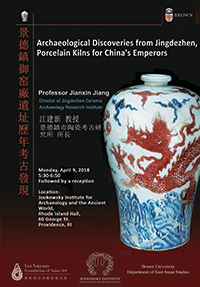JIANG Jianxin is the director of the Jingdezhen Institute of Archeology, the director of the Chinese Ancient Ceramics Society, and president of Jingdezhen Tang Ying Institute. Since the 1980s, he has engaged in archaeological studies on Jingdezhen ancient ceramics remains and led multiple archeological excavations of kiln ruins from the Ming and Qing dynasties, including excavations of kiln factory ruins. He has authored more than twenty academic papers and is a chief editor for multiple archaeological journals and catalogues.
The lecture, "Archaeological Discoveries from Jingdezhen, Porcelain Kilns for China's Emperors," recognizes and appreciates the main characteristics and transformation in style of porcelains from the kiln of Guan Yao across different periods of the Ming Dynasty, highlighting the history and culture, ceramic technology, and art history. It also presents new explorations on Guan Yao porcelain from a variety of historical periods and perspectives, including: the beginning and ending years of the Ming Dynasty, the “blank period” of Guan Yao, Yong-Le Guan Yao porcelain and Zheng He’s Voyage porcelain, Xuan-De Guan Yao’s impact on Cheng-Hua Guan Yao and technological achievements, and others. Based on recent archaeological studies and excavation data, the history of the porcelain industry in Jingdezhen can be traced back to the middle and late Tang Dynasty. The Leping South Kiln surrounding Jingdezhen started producing celadon and ceramic whiteware, its high quality influenced by Yue kilns and Xing kilns. This laid the foundation of the early Jingdezhen porcelain industry and provided a technological foundation for the future success of a celadon production. New archeological findings at the Luomaqiao Yuan Ming Kiln Site also revealed important artifacts, such as many blue-white glazed porcelains from late Song and early Yuan Dynasty, blue-white porcelains and white porcelains from the Yuan Dynasty, and early-to-middle Ming Dynasty utensils with various styles, many methods of decoration, and a high technological level. According to the quality of the unearthed porcelains, the kiln site may have been an important fixed-point firing kiln site for the Yuan Dynasty Fuliang Porcelain Bureau.
Presented in Chinese with English translation

